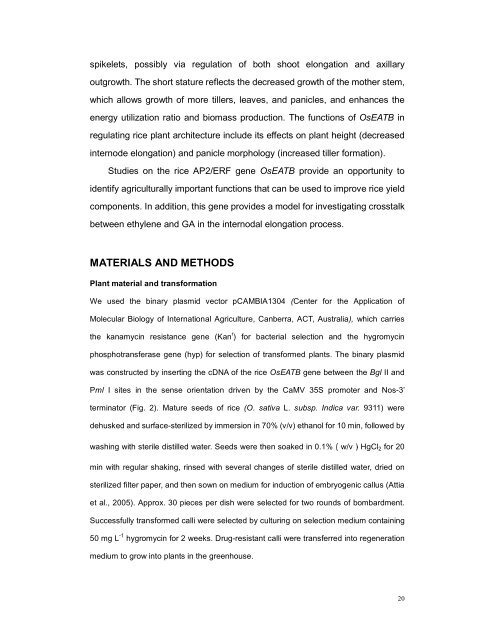Rice ERF OsEATB restricts GA biosynthesis - Plant Physiology
Rice ERF OsEATB restricts GA biosynthesis - Plant Physiology
Rice ERF OsEATB restricts GA biosynthesis - Plant Physiology
Create successful ePaper yourself
Turn your PDF publications into a flip-book with our unique Google optimized e-Paper software.
spikelets, possibly via regulation of both shoot elongation and axillary<br />
outgrowth. The short stature reflects the decreased growth of the mother stem,<br />
which allows growth of more tillers, leaves, and panicles, and enhances the<br />
energy utilization ratio and biomass production. The functions of <strong>OsEATB</strong> in<br />
regulating rice plant architecture include its effects on plant height (decreased<br />
internode elongation) and panicle morphology (increased tiller formation).<br />
Studies on the rice AP2/<strong>ERF</strong> gene <strong>OsEATB</strong> provide an opportunity to<br />
identify agriculturally important functions that can be used to improve rice yield<br />
components. In addition, this gene provides a model for investigating crosstalk<br />
between ethylene and <strong>GA</strong> in the internodal elongation process.<br />
MATERIALS AND METHODS<br />
<strong>Plant</strong> material and transformation<br />
We used the binary plasmid vector pCAMBIA1304 (Center for the Application of<br />
Molecular Biology of International Agriculture, Canberra, ACT, Australia), which carries<br />
the kanamycin resistance gene (Kan r ) for bacterial selection and the hygromycin<br />
phosphotransferase gene (hyp) for selection of transformed plants. The binary plasmid<br />
was constructed by inserting the cDNA of the rice <strong>OsEATB</strong> gene between the Bgl II and<br />
Pml I sites in the sense orientation driven by the CaMV 35S promoter and Nos-3’<br />
terminator (Fig. 2). Mature seeds of rice (O. sativa L. subsp. Indica var. 9311) were<br />
dehusked and surface-sterilized by immersion in 70% (v/v) ethanol for 10 min, followed by<br />
washing with sterile distilled water. Seeds were then soaked in 0.1%(w/v)HgCl2 for 20<br />
min with regular shaking, rinsed with several changes of sterile distilled water, dried on<br />
sterilized filter paper, and then sown on medium for induction of embryogenic callus (Attia<br />
et al., 2005). Approx. 30 pieces per dish were selected for two rounds of bombardment.<br />
Successfully transformed calli were selected by culturing on selection medium containing<br />
50 mg L -1 hygromycin for 2 weeks. Drug-resistant calli were transferred into regeneration<br />
medium to grow into plants in the greenhouse.<br />
20

















